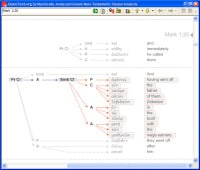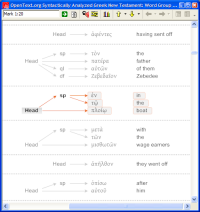It’s been awhile since I’ve posted about Greek syntax. In the interim, Eli has been regaling us with graph theory and all sorts of other chunky syntactical goodness.
Well, the drought is over.
Word groups are cool, but clauses are more cool. Why? Because you’re at a higher-level structure and you can really start to dig into things you haven’t been able to dig into before. With relationships between words, at least one can approximate (somewhat) using morphological criteria and word proximity.
The clause level is a bit more difficult to approximate. A clause (linguistically speaking) and a sentence are not equivalent. So even setting a sentence as a search boundary, while useful, is not the same thing. Sentences may sometimes be clauses, and clauses may sometimes be sentences; but many times multiple clauses are contained in what the Nestle-Aland denotes a sentence.
The OpenText.org material breaks the New Testament down into primary clauses and secondary clauses. Sometimes, clauses are embedded within other clauses.
Before I go too much further, I can sense that some vocabulary review would be helpful. So … hold on to your hats! Time for some vocab.
OpenText.org Clause Analysis Vocabulary
- Clause
- A clause is a unit of language that contains a single proposition about which the language user is making an assertion, negation, query or suggestion. A clause will usually consist of a verbal element (the predicator) and its related elements. However, a verbal element will not always be present (e.g. the opening of many letters) and is not required in a clause. A clause may consist of a single word group (e.g. a one-word phrase).
- Clause component
- A clause component is a functional unit made up of one or more word groups and can be classified as either core types (subject, predicator, complement, adjunct) or peripheral types (addressee, conjunction).
Clause components, as mentioned above, are broken into two types:
Core Clause Components
- Subject
- The subject of a clause is the word group or word groups providing greater specification regarding the grammatical subject of a finite verb form (the morphological indication of person and number). For finite verbs the head term of this group (or these groups) are in the nominative case. In infinitive clauses the subject may be indicated in the accusative case. In so-called genitive absolute contructions the subject component occurs in the genitive case. A clause will often have no subject component and can have at most one subject component.
- Predicator
- The predicator of a clause is its verbal element, which grammaticalizes the process of the clause.
- Complement
- A complement of a clause is a word group or the word groups that completes the predicator of the clause. The categories of direct and indirect object from traditional grammar are among those classified as complements. A clause may have no complement or many complements. With relation to the process of the clause, the complement(s) are those components of the clause that answer the question who? or what? is affected by the process.
- Adjunct
- An adjunct of a clause is a word group or the word groups that modify the predicator, providing an indication of the circumstances associated with the process. Common adjuncts are prepositional and adverbial phrases (adverbs) and also embedded adverbial clauses. With relation to the process of the clause, adjuncts provide answers to questions of the type where?, when?, why? and how?.
Peripheral Clause Components
- Addressee
- The addressee component serves an interpersonal function and contains words used to call attention to one of the participants (either internal or external) in the discourse.
- Conjunction
- The conjunction component contains words that function to link the clause to preceding or following clauses in the discourse.
Enough with the vocab, let’s work through a verse or two. Or five. Last Sunday, the pastor at the church I attend preached on Mark 1.16-20, so that seems like a good place to start. Here’s the text:
| Greek (NA27) | English (ESV) |
| 16 ??? ??????? ???? ??? ???????? ??? ????????? ????? ?????? ??? ??????? ??? ??????? ??????? ????????????? ?? ?? ???????· ???? ??? ??????. 17 ??? ????? ?????? ? ??????· ????? ????? ???, ??? ?????? ???? ???????? ?????? ????????. 18 ??? ????? ??????? ?? ?????? ??????????? ????. 19 ??? ?????? ?????? ????? ??????? ??? ??? ????????? ??? ??????? ??? ??????? ????? ??? ?????? ?? ?? ????? ????????????? ?? ??????, 20 ??? ????? ???????? ??????. ??? ??????? ??? ?????? ????? ????????? ?? ?? ????? ???? ??? ???????? ??????? ????? ?????. | 16 Passing alongside the Sea of Galilee, he saw Simon and Andrew the brother of Simon casting a net into the sea, for they were fishermen. 17 And Jesus said to them, Follow me, and I will make you become fishers of men. 18 And immediately they left their nets and followed him. 19 And going on a little farther, he saw James the son of Zebedee and John his brother, who were in their boat mending the nets. 20 And immediately he called them, and they left their father Zebedee in the boat with the hired servants and followed him. |
There is a lot going on in those five verses. I want to concentrate on verse 20.
The OpenText.org Clause Analysis breaks the text into two primary clauses. The first clause consists of a conjunction that acts at the paragraph level joining the clause to the previous clause; an adjunct (“immediately”, providing the circumstance of the clause); the predicator or ‘verb’; and a complement or (in this case) the object of the verb.
The second clause is the interesting one, though. Its structure is largely the same conjunction, adjunct, predicator, then adjunct instead of complement.
The first adjunct, however, consists of an embedded clause. And this is where the fun starts … er, continues (what, hasn’t this been fun?) The embedded clause is a predicator and complement (verb and object) that tells us ‘they’ (James & John) left their father, Zebedee, to follow Jesus. But they didn’t just leave their father; there are two adjuncts in this clause that provide the circumstance of their leaving. These are prepositional phrases, which is evident upon consulting the OpenText.org Word Group Analysis.
James and John left Zebedee in the boat (where they had been mending nets, cf. v. 19) with the hired help.
Using the syntax graphs, we’ve stepped through the clause components for two primary clauses to get a better idea of the structure of the text. In so doing, we’ve gained a little clearer picture of what the text is communicating and the relationship between the clause components and the word groups that comprise the clause components.
And let’s not forget all of this stuff is searchable. That’s where I’ll go in my next post.






